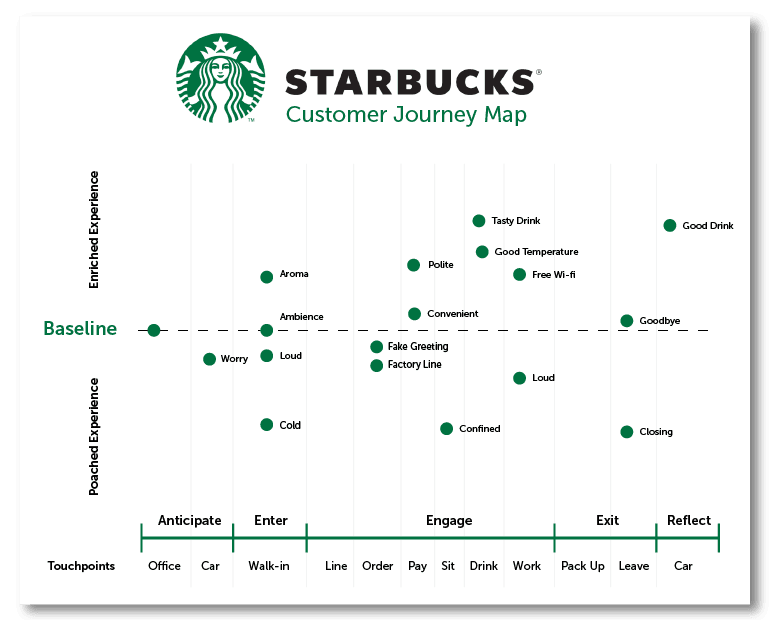How to Make an Effective Customer Journey Map The Best Way
 As a marketer, it would be helpful to be inside the heads of our customers for a little bit. Wouldn’t it be nice to know the answers to questions like:
As a marketer, it would be helpful to be inside the heads of our customers for a little bit. Wouldn’t it be nice to know the answers to questions like:
- What are they feeling and thinking when they first start to search for a solution to their problem?
- What caused them to quit looking at a certain product before they purchased?
- What led them to choose one solution over another?
How to Make an Effective Customer Journey Map The Best Way via @CoSchedule
Click To TweetDownload Your Free Customer Journey Mapping Template
Before you continue reading download your customer journey mapping template. This spreadsheet will help you sort and organize the data that you’ve gathered about their experiences searching for a product. From there you can easily spot gaps in their experiences that your company can fill with the right information and attract the right customers to increase your conversions.Get Your Free Customer Journey Mapping Template Bundle via @CoSchedule
Click To TweetWhat Is Customer Journey Mapping?
Customer journey mapping is:An exercise that allows a brand to understand and improve a customer’s experience when they attempt to shop for their product. It tells the story of a person’s experience when they first start shopping for a product and continues through to the process of them purchasing a solution.
What is customer journey mapping, and why do marketers need to understand it?
Click To Tweet6 Customer Journey Map Examples
Each customer journey map is different depending on the organization or industry that creates it. Look at these seven industries and businesses and notice how different their maps are.Health Insurance Industry
This health insurance customer journey map from Heart of the Customer integrates goals that their customer wants to achieve during their shopping process.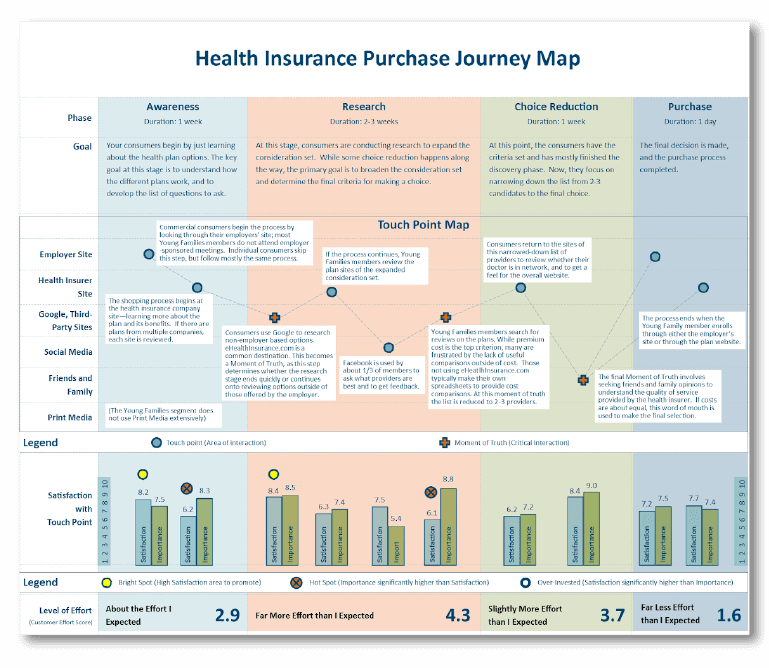
Preact
Preact follows a more traditional path for creating a customer journey map. Instead of focusing on a variety of different emotions, Preact focus on the frustrations their customers feel during their shopping experience.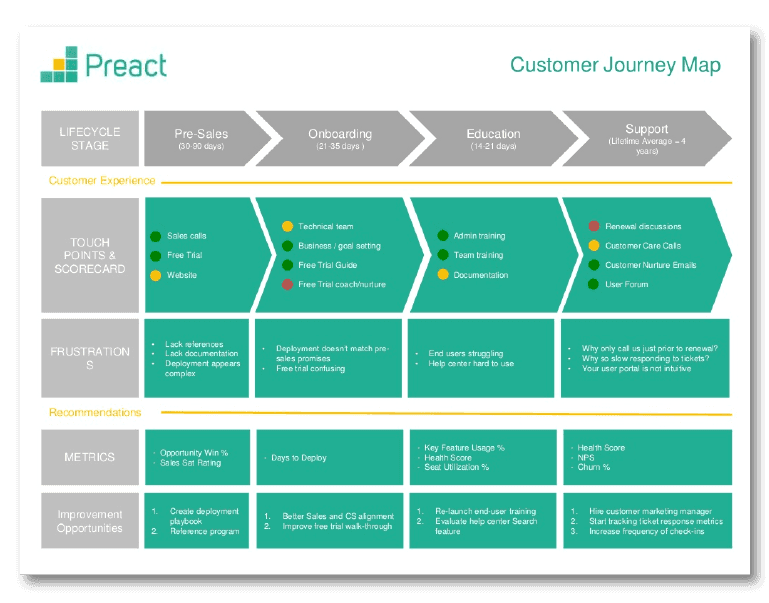
Online Travel Company
This online travel company customer journey is unique in the fact that it has broken down it’s stages into multiple parts instead of the standard four.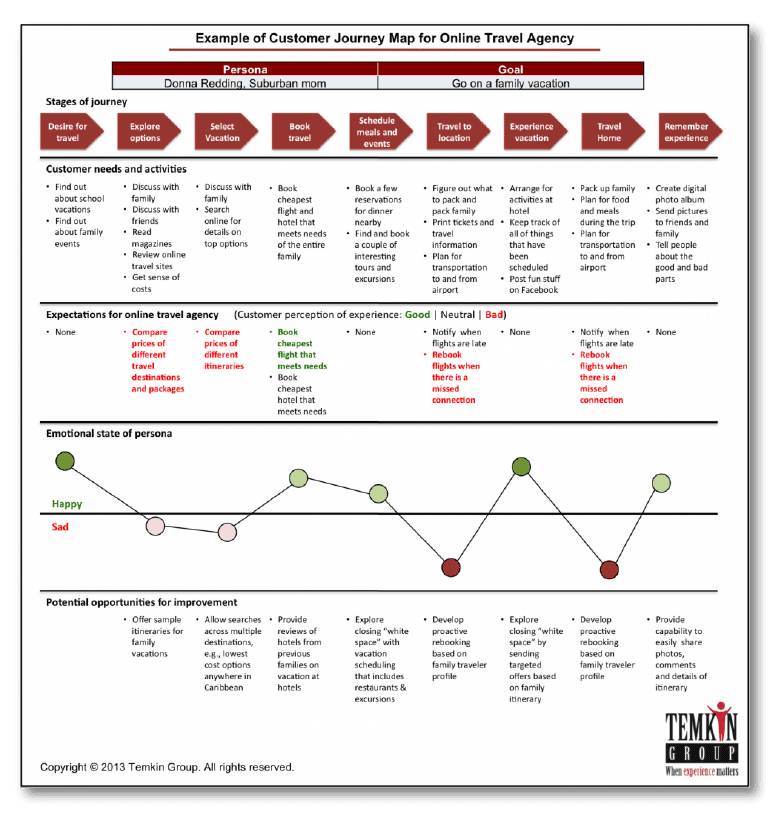
B2B Customer Journey
This B2B customer journey map is laid out like a designed infographic rather than a traditional customer journey map.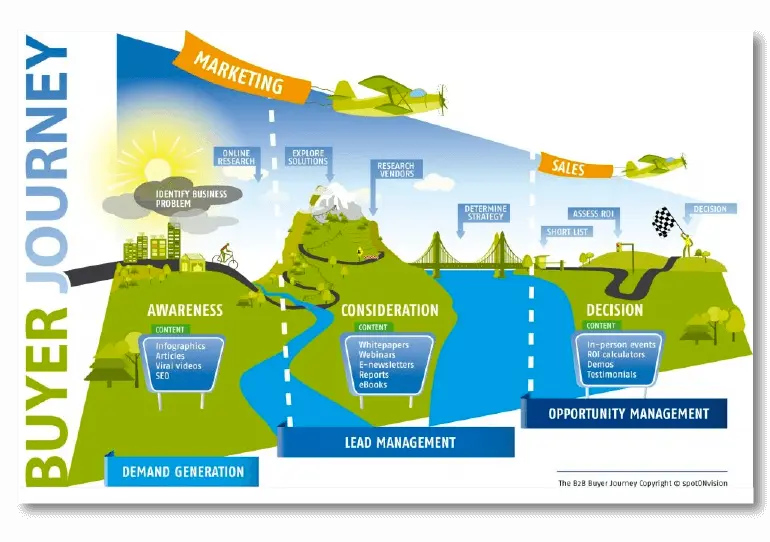
Yahoo
Yahoo’s customer journey map is structured more like a flow chart, making it easy to track customer progress.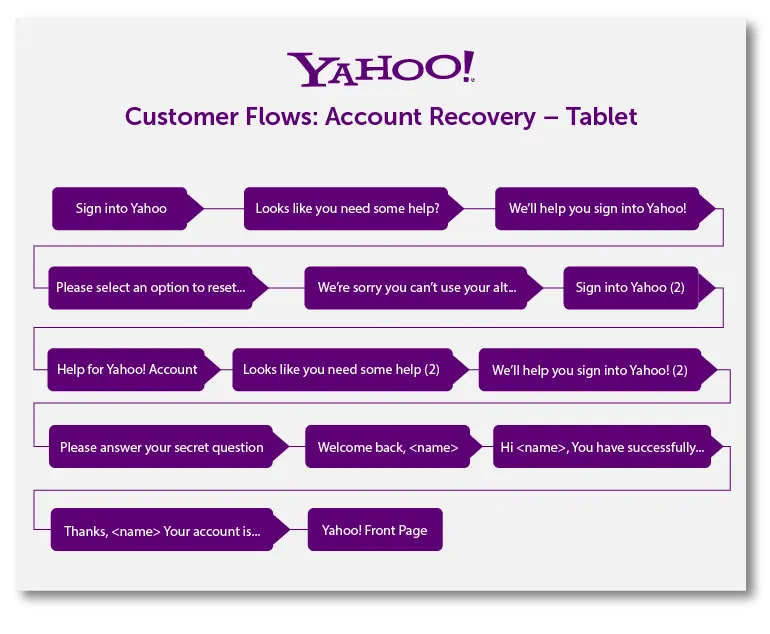
11 Steps To Properly Map Your Customer Journey
The following eleven steps will help you gather the data you need to create a customer journey map that summarizes their experiences shopping for a product. Each phase of your map will follow the marketing funnel and help guide you in creating the right message at the right time to encourage conversions. As a quick review, the stages in your map (and your marketing funnel) are:- Discovery: Your customers are just beginning to understand what your brand is about. They are experiencing some pain point in their life, and they aren’t sure how to fix it.
- Consideration: They are now aware that there are solutions to the problem they are facing and that your brand offers one. What they don’t know is that your brand provides the best solution to their problems.
- Purchase: They know about your solution and think you are the best option, but they need one last little shove over the line to buy your product.
- Retention: Your product has been bought by your customer, and you give them additional information to ensure they continue to love their products.

Here's how to create a customer journey map in 11 steps via @CoSchedule
Click To TweetStep One: Gather Any Existing Data On Your Audience
The ultimate goal for you is to attract customers like your existing best customers.Therefore the first step is to gather any existing data the organization has on your target market. This is important because existing data can give you the information you need for who you have been or are currently targeting. By knowing who you’re targeting you’ll be able to learn more about their personality and how they handle their shopping experience. However, if your target audience has changed, you need to be able to see if any of the old information you have is useful. Look for old audience personas, surveys, or collections of data that may have been gathered. You may need to check in with upper management to find where that data has been stored. As you read through old data answer the following:- Does the persona here still reflect our current potential buyer?
- Is our product or service still helping solve the problems these people were experiencing?
- When was the data collected?
- Talk to upper management and find places where older audience data and personas may be stored.
- Look through data to see if it still applies to the customers you want to focus on now.
- Keep what is applicable and file away the rest.
Step Two: Gather Data From Your Website And Social Media
Once you have gone through research that has already been collected by your organization, you can move on to gathering data from your website and your social media channels to see the types of people you are attracting to your website. Your website analytics can give you information about where your audience is coming from and what kind of roadblocks they are running into while they search for information on your site. Your social media can show you more about who is following your organization and who is interested in your product.Collecting Website Data
Using Google Analytics, you can collect data points on:- Age
- Gender
- Location
- Interests
- Language
- And even the device that they’re browsing your website from.
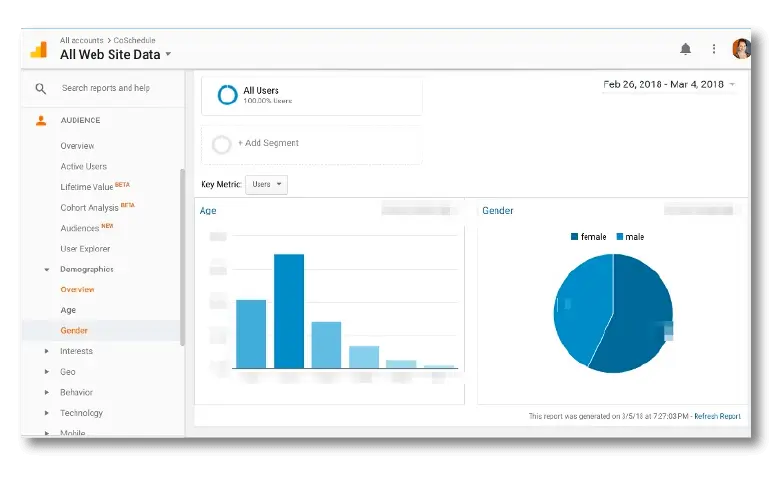 As you pull your data look for trends and patterns that may indicate that people belonging to a particular age group, job category, or location are consistently visiting your site.
Another section of your Google Analytics that will provide useful information for your customer journey map is your User Flows. This section of your analytics will show you the first and second touchpoints that your users are reaching when they first enter your site.
You can access this data by going to Audience > User Flow.
As you pull your data look for trends and patterns that may indicate that people belonging to a particular age group, job category, or location are consistently visiting your site.
Another section of your Google Analytics that will provide useful information for your customer journey map is your User Flows. This section of your analytics will show you the first and second touchpoints that your users are reaching when they first enter your site.
You can access this data by going to Audience > User Flow.
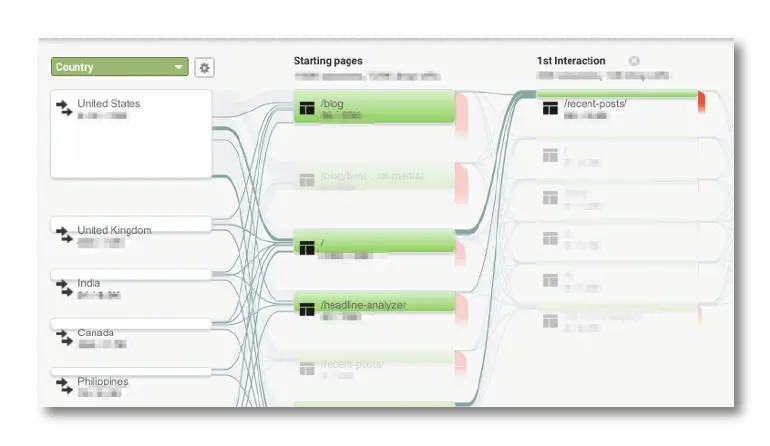 This information can be vital to show you where users are getting hung up and exiting your site.
By locating those hang-ups and finding what information you need to include, you can patch the leak and potentially raise conversions.
Now each of your social media channels will gather its internal demographics that you can collect and record. Here is where to find that information on every social media channel.
On each channel that your organization is active on, pull the demographic data and see where the data from your Google Analytics and the data from your social media pages overlap.
This information can be vital to show you where users are getting hung up and exiting your site.
By locating those hang-ups and finding what information you need to include, you can patch the leak and potentially raise conversions.
Now each of your social media channels will gather its internal demographics that you can collect and record. Here is where to find that information on every social media channel.
On each channel that your organization is active on, pull the demographic data and see where the data from your Google Analytics and the data from your social media pages overlap.
- Run a Google Analytics audience report for the past six months.
- Note demographic data in a separate data sheet.
- Run a User Flow for the past six months.
- Note which paths your audience is taking and where they are dropping off and leaving your website.
- Record those flows.
- Gather demographic data from your social media sites and record them.
- Look for trends and overlapping patterns.
Step Three: Talk To Co-Workers In Customer-Facing Operations
You have a lot of data on your hands by now, but you’re not done yet. Creating a customer journey map means that you need to know every detail about your customer’s experience to tell their story accurately. Next, you need to talk with co-workers who interact with your customers daily. Why would something like this be relevant? Because your co-workers in these roles are in front of your audience all the time. They are the first ones to hear when something has gone well or when something is a disaster. They hear about their shopping experience first hand. Start with the following questions to help gather qualitative data on your audience:- What are common problems that our customers experience?
- What experiences have impressed our customers?
- What roadblocks have our customers ran into in the past?
- What questions come up as they search for a solution to their problem?
- What feelings have they experienced as they search for a product?
- Create the questions you’d like your co-workers to answer.
- Set up brief 15-minute interviews.
- Send them the questions in advance.
- Chat and record answers.
- Look for recurring patterns.
Step Four: Set Up In Person Interviews
It’s easy to send out a survey and have your target audience respond to questions. However, are your customers going to divulge their shopping experiences with you over a survey? Probably not. Which is why taking the time to sit down with your customers one on one is so important. You’re more likely to get the honest, in-depth answers that can help you shape the story of your customer’s journey. What questions should you include in those interviews to get the answers you’re looking for? Start with these:- What was your first thought when you realized you needed [Product]?
- If you didn’t buy [Product] what made you decide to seek another solution?
- What problem did you hope this product would solve?
- What information did you have trouble finding?
- How easy was it for you to find options?
- What would have made your purchase process easier?
- What would have made your shopping experience easier?
- Create your interview questions.
- Choose 10 to 15 customers you believe would be good interview candidates.
- Confirm five to ten interviews.
- Send your interview questions in advance.
- Attend the interview with a recording device (it’s easier than trying to take notes).
- Transcribe your interview and look for data or patterns.
Step Five: Create A Survey To Gather Qualitative And Quantitative Data
The last data gathering step in this process is creating a survey to send to customers. You can’t be everywhere at once and talking to five to ten customers alone won’t give you enough data to accurately recreate their shopping experiences. How can you ensure you’ll get the answers you need? Try adding these questions: Qualitative Questions:- What is it like using [Product]?
- What was your experience with buying [product]?
- What information could have been that would have made your purchasing process easier?
- What would make you reconsider buying a product?
- What has your shopping experience been like?
- How likely are you to purchase [Product] again?
- How did you hear about [Product]?
- How frequently do you use [Product]?
- What gender do you identify as?
- What nationality are you?
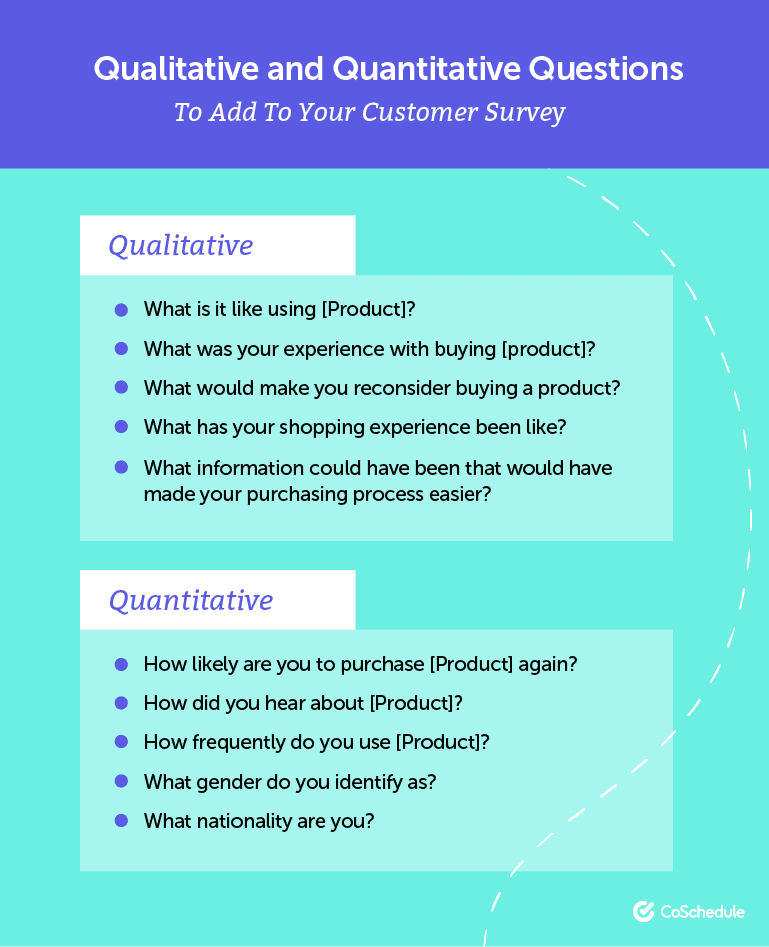 Once you have your questions figured out, you can upload them to tools like Survey Monkey, Google Forms or Polldaddy. After that share your survey link with your customers via email or social media.
Set a goal for the number of responses you want to get.
Once you have your questions figured out, you can upload them to tools like Survey Monkey, Google Forms or Polldaddy. After that share your survey link with your customers via email or social media.
Set a goal for the number of responses you want to get.
- Create your questions.
- Run your questions by co-workers.
- Upload your questions into a survey tool.
- Share the link via email or social media.
- Set a time frame to establish how long you'll collect answers.
- Record your data and look for patterns.
Step Six: Use Your Data To Build An Update Audience Persona
Now you need to sort through the data you collected to create your audience persona. What is an audience persona? At CoSchedule we define them as:Your marketing persona is a document that details your target audience’s who, what, when, where, and why, in addition to understanding general demographic information such as gender, job title, job function, business size, team size, needs, pain points, and challenges.As you go through your data, look for recurring themes, like a typical job type, age range, location, etc. Note which qualities are overlapping and add them to your audience persona. You should also look for overlapping interests and common problems that your target audience is experiencing that would cause them to need your product. Use the following template to help get your persona started:
{Insert your company} creates content to attract {insert target audience} so they can {insert desired outcome} better.
- Gather all of your data into one document.
- Highlight recurring trends and qualities.
- Use the template to start formatting your persona.
- Add in frequent problems your audience’s experiences that would cause them to want to buy your product.
Step Seven: Map Out The Discovery Phase Of Your Customer Journey Map
Now that you have your audience persona and your customer data you can begin to develop your customer journey map. The first phase is centered around discovery. This phase of your map should include:- The reason they are searching for a product.
- Their motivation for wanting to buy a product.
- How they are getting their information.
- The actions they take.
- The initial touchpoints they have with a company.
- How they are feeling.
- Their experience.
- The pain points they’re experiencing.
- Any questions they have.
The Reason They Are Buying A Product
First, establish the reason behind why someone wants to buy a product. They are searching for a solution to the problem they are experiencing and can no longer fix it themselves. In the case of our example, a reason could be that Lisa has a wedding coming up and she doesn’t have enough time to go to the mall and shop for an outfit. Record the reason why your customers would be interested in your product in your template: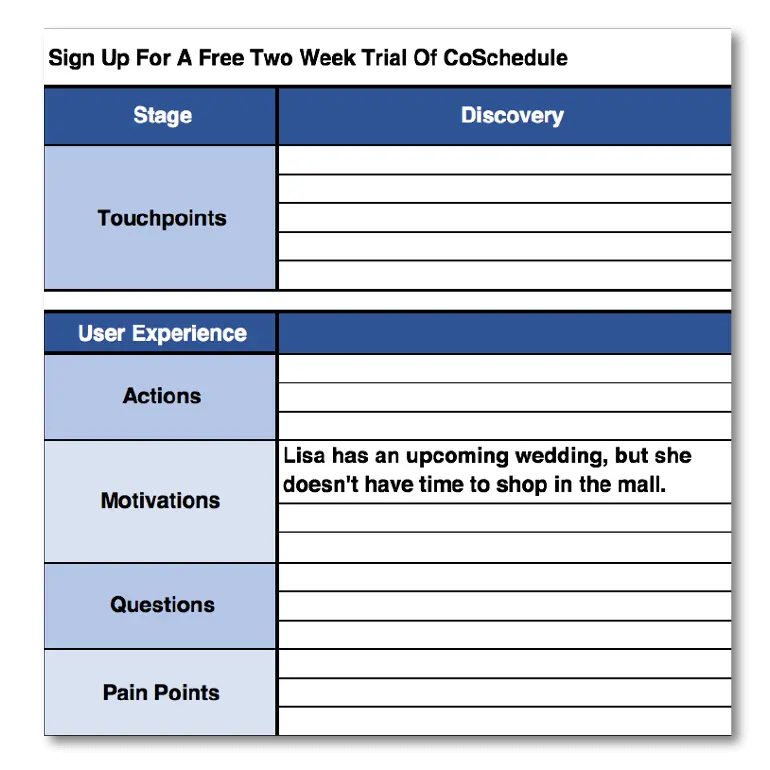
The Motivation Behind Buying A Product
There is always a reason for buying a product. In this case, Lisa needs an outfit for the wedding. However, there is also a motivating factor which in the case of our clothing example could be that Lisa wants an outfit that will make her stand out and look good at this wedding. In your template, motivations can go into one section: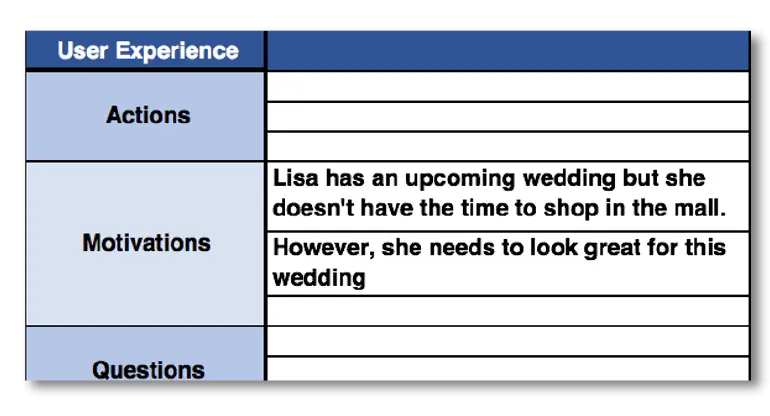
How Are They Getting Their Information
Depending on your customers, they may prefer to get their information in different ways. This could be through newspapers, advertisements, blogs, social media, etc. You need to identify how they prefer to get their information in this phase of their journey. In this case, because Lisa doesn’t have time to go to the mall she’ll be getting her information from the websites of clothing stores she visits. Record how they are getting their information in your template: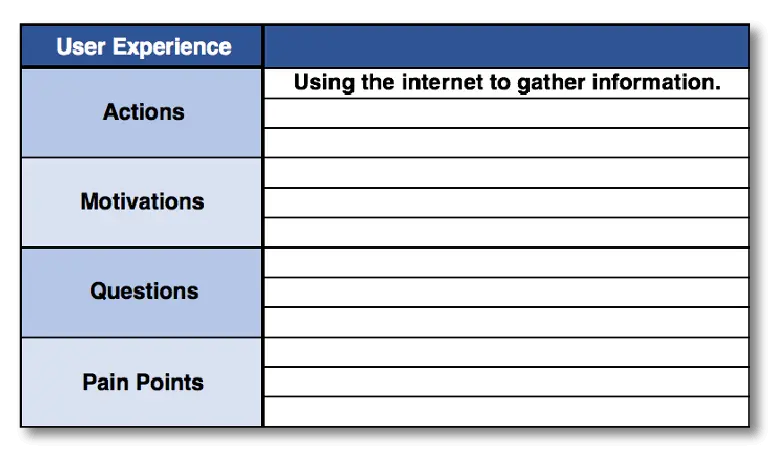
The Actions They Take
Next, is outlining the actions they’ll take to get the information they need. What does your customer need to do to find the solution they are looking for? Lisa decides that going to the mall is too much work. Then again so is online shopping, she doesn’t have time to scroll, through every website to find the right dress. So she types “personal shopper” into Google and sees an ad for a clothing subscription company. Lisa decides to click on the ad which takes her to the website. List all the actions that your customer could take in your template: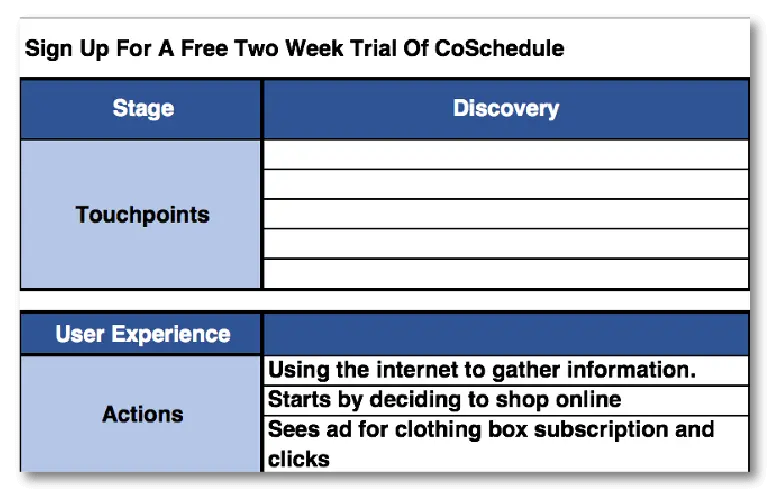
What Are The Initial Touchpoints A Customer Has With Your Company?
Your initial touchpoints in a customer journey map revolve around the first time they interact with an organization that sells the product or service they are looking for. (Remember this is a generalized experience, not just the experience they have with your brand.) In Lisa’s case her initial touchpoints will be:- She sees the ad in her Google results.
- She clicks on the ad.
- She sees the homepage (or landing page) for the first time.
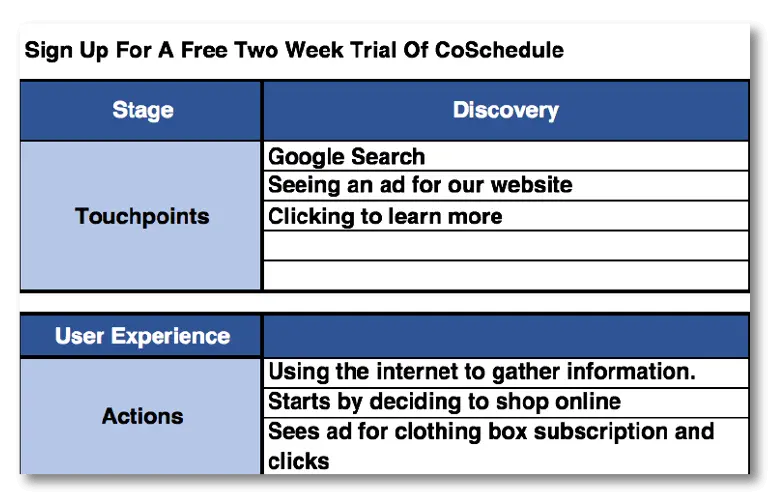
Document How Your Customer Is Feeling
Part of telling your story involves explaining how your customer feels. You can’t leave out that kind of information because how the customer feels affects their entire experience. And it doesn’t begin once they click an ad and learn about your organization. This starts before they even begin to search for your product. In Lisa’s case, she was feeling stressed because she needed a great outfit for an upcoming wedding and was worried she didn’t have enough time to shop. She thought about online shopping, but that just made her frustrated because she didn’t have time to scroll through pages of dresses. But, she feels defeated because she doesn’t have a choice. She starts her search and becomes intrigued with an ad that talks about someone who could do her shopping for her. Record those emotional highs and lows in your template: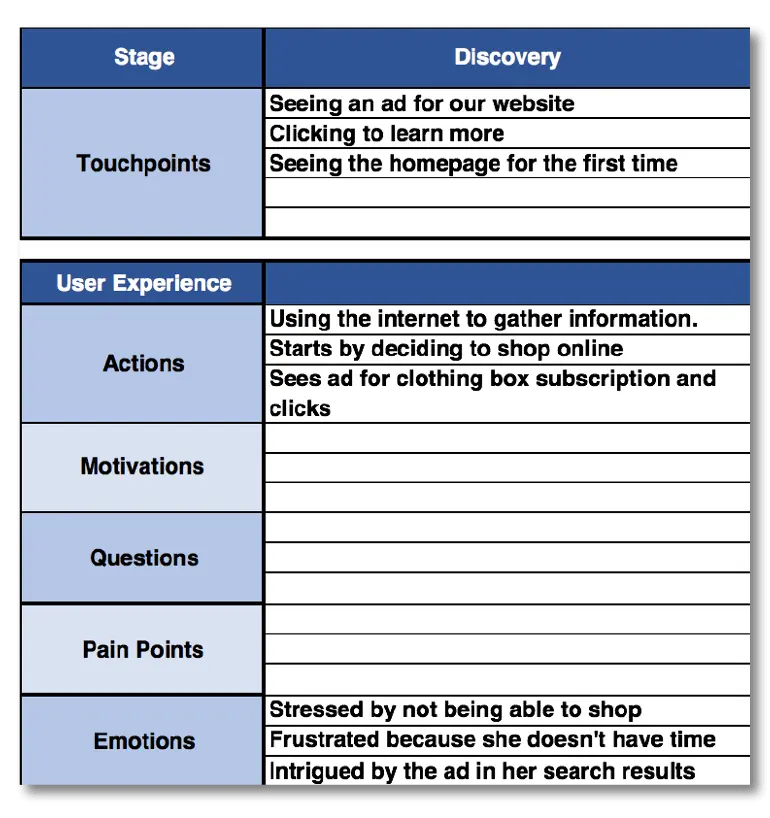
Their Experience Thus Far
Next, you need to document their experience. How are things going? For Lisa, it’s going pretty well; there’s a chance that someone will do all of the shopping for her!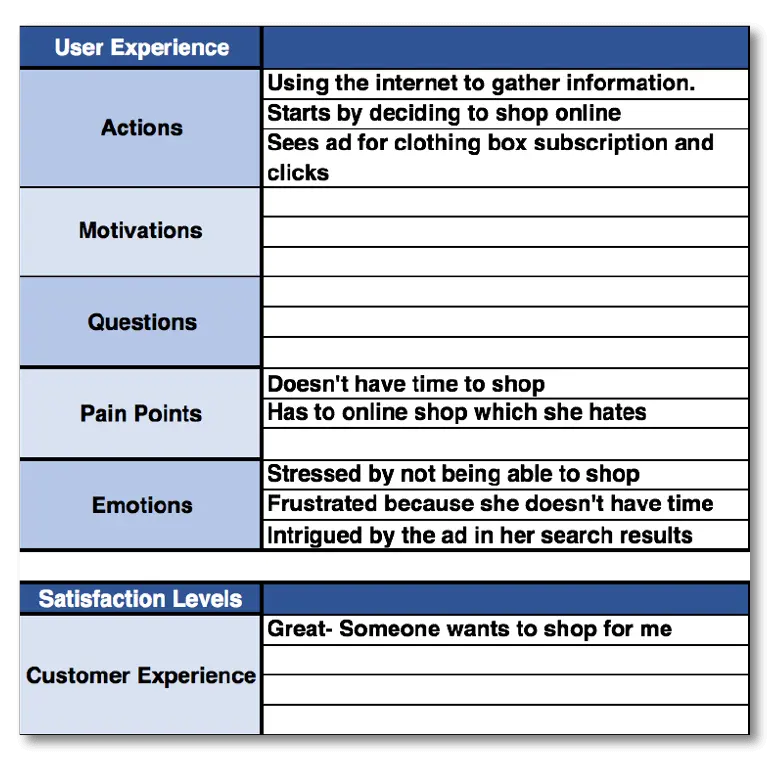
The Pain Points They’re Having
At this point, you need to address any pain points that your potential customer may be having. Lisa’s pain points revolve around the fact that:- She has a wedding that she doesn’t have time to shop for.
- She has to resort to online shopping, but she hates scrolling through page after page of dresses.
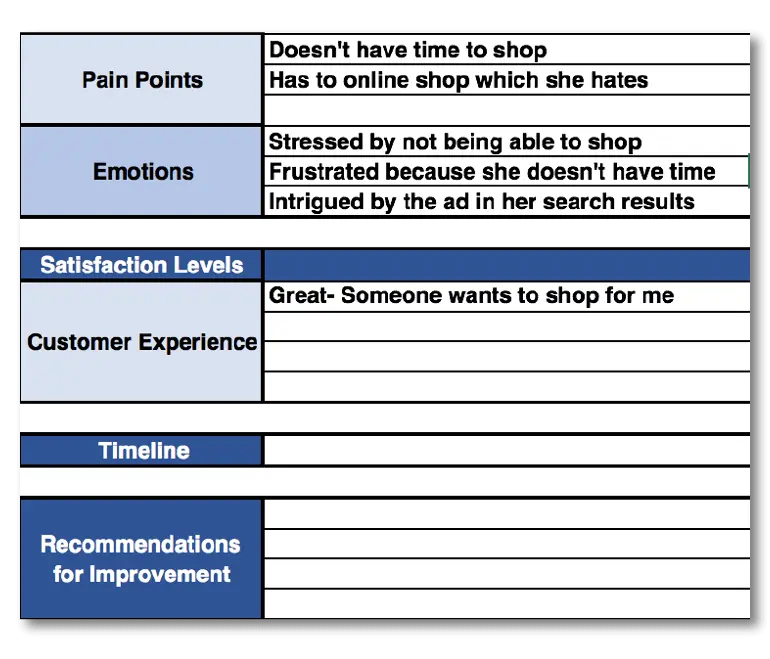
What Questions Do They Currently Have
You need to identify any questions they might have at this phase in their journey. Why? Because by anticipating questions that occur during their shopping experience, your organization can be proactive and already have them answered. For Lisa the following questions might come up in this phase of her journey:- Is there a better way to shop online?
- Can someone do this for me?
- What is this site?

What Recommendations Do You Have?
Now that the discovery phase of this customer journey map is over you can list any recommendations that would help improve the shopping experience for your potential customers. For this example, we might suggest adding additional ad copy that explains how a clothing subscription box can do all of the shopping for their customers. So what does this look like formatted into an actual map? Something like this: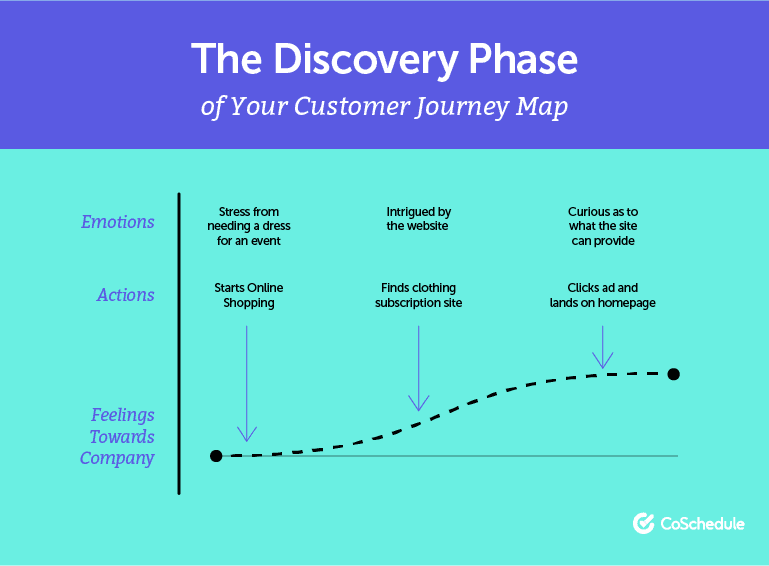
Step Eight: Map Out The Consideration Phase Of Your Customer Journey.
Now that your potential customers know that your product exists they are going to start to consider if they want to buy your product. You’ll need to outline the following information in your template:- Their motivation for wanting to learn more about a product.
- The actions they take.
- The touchpoints they have with a company.
- How they are feeling.
- Their experience.
- The pain points they’re experiencing.
- Any questions they have.
What Is Motivating Them To Learn More About Your Product
At this point, your customer knows you might have the solution to their problem. You need to identify what message they need to hear that would entice them learn more. If we go back to our example, Lisa’s motivation to learn more would be to see if someone really would do her clothes shopping for her.What Actions Do They Take
You’ve got your customer hooked in and motivated to learn more. Identify what actions they will take to do this. For example, those actions could look like this.- She clicks the about us page and sees that it’s a personalized box of clothing delivered straight to her door.
- She reads more about how the process works and learns that she needs to take a quiz before they send her clothes.
- She clicks the quiz and sees she needs to create an account to continue.
- She creates an account and starts the quiz. After about 20 questions, she realizes it’s extensive.
- She sees that the company needs her measurements and has to google what size she is.
- She is asked about her price range and is curious about how cheap the cheapest option is.
- She leaves the quiz and searches online for reviews.
- She finds a few blogs that have positive reviews about the boxes.
- From the reviews, she sees that the clothes are spendy, but she can swing it.
- She wants to continue the quiz again.
- She can’t find the quiz.
- She looks in the help docs to find where the quiz is.
- She continues the quiz.
- She asked how often she wants a box delivered, so she leaves the page to see if she can do the box once.
- She scrolls through four help documents before seeing that she can schedule a one time box.
- Now she has to deal with the hassle of finding the quiz again.
- She is warned about a service fee.
- She wants to find what the service fee is for.
- She can’t find anything on the website, so she goes back to the reviews.
- She finds out what the service fee is.
- She finishes the quiz and is asked for payment.
The Touchpoints Your Potential Customers Have
At this phase in your customer’s journey, they are going to have multiple touchpoints with an organization. It’s up to you to list out point they could come into contact with. For our example, that list could be:- The homepage
- The account creation page
- Their “my account” page
- The quiz they take
- The help center
- The frequently asked questions page
- Articles that review the products a customer is looking for.
How Are They Feeling?
For each action that your customer takes they’re probably experiencing some emotional shift. For example:- Lisa is excited because she learns that someone can do her shopping for her.
- However, after finding out she needs to create an account to take the quiz, she’s a little annoyed but optimistic.
- She becomes frustrated with how long the quiz is.
- Then she’s confused because she doesn’t know her measurements.
- Now she’s a little nervous because how expensive are these clothes? She’s on a budget after all.
- After a few reviews, she’s confident she can afford a box.
- And now she’s flustered again because she can’t find the quiz and will be angry if she has to fill out all those questions again.
- She’s hesitant now because she only wants to order the box once to try it. So she goes back to the review to see if they said anything about only ordering a box once.
- She’s happy again because she can schedule one box.
- After the service fee is introduced, she’s annoyed because now they want her to spend more money?
- Now, she’s angry because she can’t find out what the service fee is for and has to go back to the reviews again.
- Once she’s read a little more, she sees it can be applied towards her total.
- She’s relieved that she’s finally finished the quiz and is brought to the payment screen.
What Is Their Experience?
Documenting your customer’s experience during this phase is essential because it can show you the gaps you need to fill. Filling those gaps allows you get ahead of a problem before it begins. In our example, you can see that Lisa had to spend a lot of time going off the website to find the information she was looking for. Not to mention she was already caught off guard by how long the quiz was and frustrated when she couldn’t find it again right away.What Pain Points Are They Having?
It’s important to identify pain points in the consideration phase of your customer journey because these are incidences that could potentially cause your customers to choose one business over another. If you can eliminate those pain points for them why wouldn’t they choose you? In Lisa’s case, had the information she was looking for been easily found on the website, she may not have gotten so frustrated trying to get answers.What Questions Do They Have?
In the consideration phase knowing the questions that your customers will have when learning about your product will save you time in the long run. Why? Because you can anticipate those questions and have them answered before they even come up. Some questions that might come up in our example are:- How many boxes can I order?
- Do I have to order more than one box?
- How much is the service fee and what is it for?
- What are my actual measurements?
- How can I find the quiz again if I left it in progress?
- How long is this quiz?
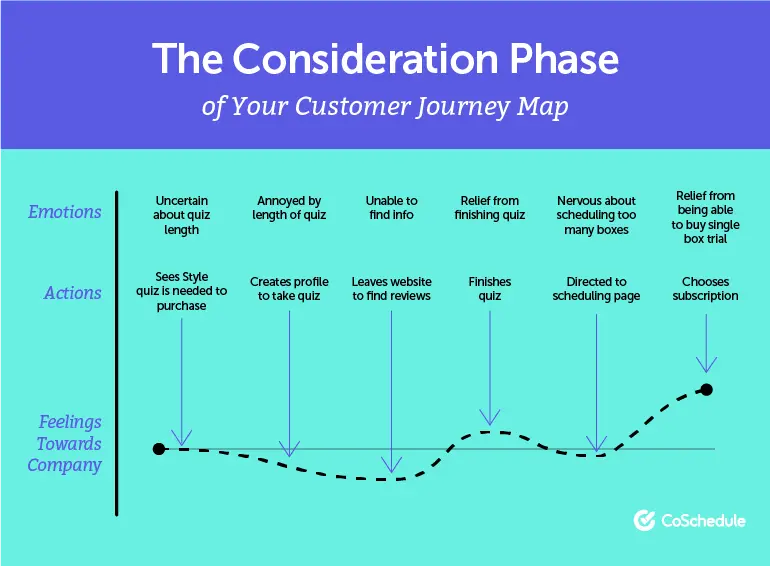
Step Nine: Map Out The Purchase Phase Of Your Customer Journey
The next part of your customer journey involves making a purchase (hopefully from you). Tracking their journey through this process is crucial because you want their experience to be as hassle-free as possible. Here’s what you’ll need to outline in your template:- Their motivation for buying a product.
- The actions they take.
- The touchpoints they have with a company.
- How they are feeling.
- Their experience.
- The pain points they’re experiencing.
- Any questions they have.
The Motivation To Buy A Product
What caused your customer to take the plunge and buy a product? Was there a specific benefit that one choice provided over another? You need to identify what that final push was and see if you can create something better to compete with it. In our example, we could say that Lisa was motivated to choose Company A over Company B because they offered a free box for every five purchased.The Actions They Take
Now it may seem simple to track the actions they take during the purchase phase. They give their payment information, and they’re done. However, you want to ensure that this process is as smooth as possible, so they don’t leave the transaction halfway through. In our example, Lisa would take the following actions:- Continue to the pricing page.
- Fill out her billing and shipping address.
- Enter her credit card information.
- Confirm the purchase.
- Receive an instant email with the estimated delivery time and tracking information.
The Touchpoints They Have With The Company
At this point, all the of the touchpoints are centered around one specific company. If you’re in the process of buying something it usually involves a touchpoint or two like:- Proceeding to the billing page.
- Receiving an email with the invoice.
- Seeing the link to FAQ pages around product shipment.
Their Experience
Tracking how this process goes for your customers can let you see snags and get in front of them to make sure you don’t miss out. If other brands are missing out on customers, what is it about their process that is turning people away? How can you avoid that? In Lisa’s case, her experience was smooth because the website had code built in that automatically filled in her billing, shipping and payment information.If other brands are missing out on customers, what is it about their process that is turning people away? How can you avoid that?
Click To TweetThe Pain Points They’re Experiencing
At this phase in your customer’s journey, you need to make sure all the kinks are smoothed out. Does this process smoothly flow from point A to point B? If it doesn’t what can you do to make it easier? In our example, Lisa didn’t have too many problems in this step because the company she chose automatically filled in her forms, saving her time.What Questions Do They Have?
Once your customer is ready to convert, you should have all of their questions answered right? Wrong. They need to know when they’re getting their product and what to expect when it gets here. What if something goes wrong? How long do they have to return it? Anticipate those questions in advance and call them out in the purchasing process, so people don’t have to wonder. How do you know what questions they might have? By going through your customer interviews! Some example questions Lisa might have are:- When will my box get here?
- Is shipping free?
- What if I don’t like what’s in the box?
- How do I pay for the items I like?
- How long do I have to return the items?
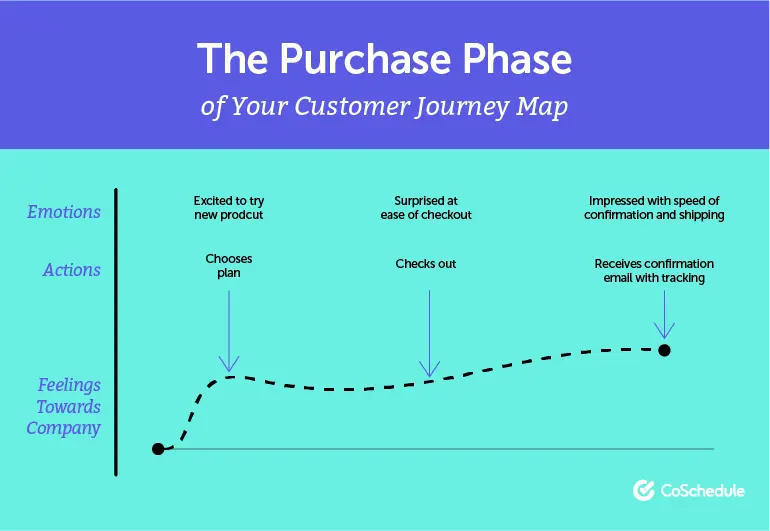
Step Ten: Map Out The Retention Phase Of Your Customer Journey
The last phase of your journey is retention. This is how you create loyal customers and keep them coming back to buy your product. At this point, your customer has purchased your product, but you want to follow up to make sure their experience was as memorable as possible. And hopefully, convince them to buy from you again in the future. So what should be outlined in your customer journey map?- Their motivation to order again.
- The actions they take after the product has been purchased.
- The touchpoints they have with a company.
- How they are feeling.
- Their experience.
- Any questions they have.
Here's how to map out the retention phase of the customer journey:
Click To TweetHow To Tap Into The Motivation To Order Again
After a customer has completed their order it’s up to the company to recreate the motivation to order again. This could be through follow up emails, special offers, or sales. In Lisa’s case, she was motivated to order again because she received an email coupon for half off a box of clothes.The Actions They Take
After a product is purchased, it will be used. Depending on the experience they could post a great or not so great review. They could also be ready to order again (not necessarily from the same company). For Lisa, her actions post-purchase would be:- Tracking her box.
- Picking up the box from the post office.
- Trying on the clothes.
- Deciding which ones she likes.
- Keeping the ones, she likes and shipping the ones she didn’t back to the company.
- Filling out the card to tell her stylist what she did and didn’t like about her first box.
Maintaining Touchpoints With Your Customers
After a customer has made a purchase it’s important to identify and support those touchpoints. You want them to think about your company after all. You could maintain those touchpoints through follow up calls and emails, surveys etc. Lisa’s final touchpoints with this company would be:- Receiving the clothing.
- Shipping back what she didn’t like.
- Giving feedback to her stylist.
- Leaving a review about her experience.
- Seeing the follow-up email from her stylist who asked how the dress went over at the wedding
- Getting the half off a box of clothes coupon.
How Are They Feeling?
Is the end of your customer’s transactions inherently good or bad? Are they usually happy when they’ve ordered this type of product? What makes that so? If a company has developed a positive reputation what are they doing to create it? For Lisa, she was ecstatic when her box arrived and pleased when she found an outfit or two that worked for her. The only problem was she had trouble trying to get the shipping label to print so she could send the other clothes back.Their Overall Experience
At the very end, your customers are going to judge their overall experience. And no it won’t be segmented off like this, they will look at their experience as a whole. You need to figure out what went well for them and what could use improvement. Is there anything in their experience that would inhibit them from ordering again? Lisa would definitely order a box again. However, it would only be for special occasions as the clothes were slightly out of her budget range.Any Last Questions?
You may have noticed that there is a small space on your template labeled timeline. Each phase of your customer journey lasts a certain amount of time which needs to be mapped out. From the first interaction to your customer receiving their product, how long does that process take? In our example, final questions like might have are:- When is my product going to get here?
- How do I care for the clothing inside?
- How do I style the clothing inside?
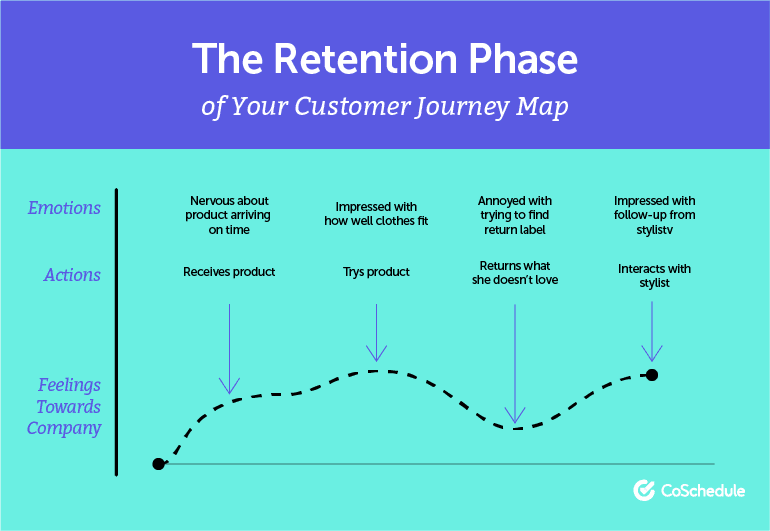
Step Eleven: Develop Your Timeline
You may have noticed that there is a small space on your template labeled timeline. Each phase of your customer journey lasts a certain amount of time which needs to be mapped out. From first interaction, to your customer receiving their product, how long does that process take? Now, this isn’t set in stone; these are estimates of how long your customer will be in each phase. Our example might look like this.
